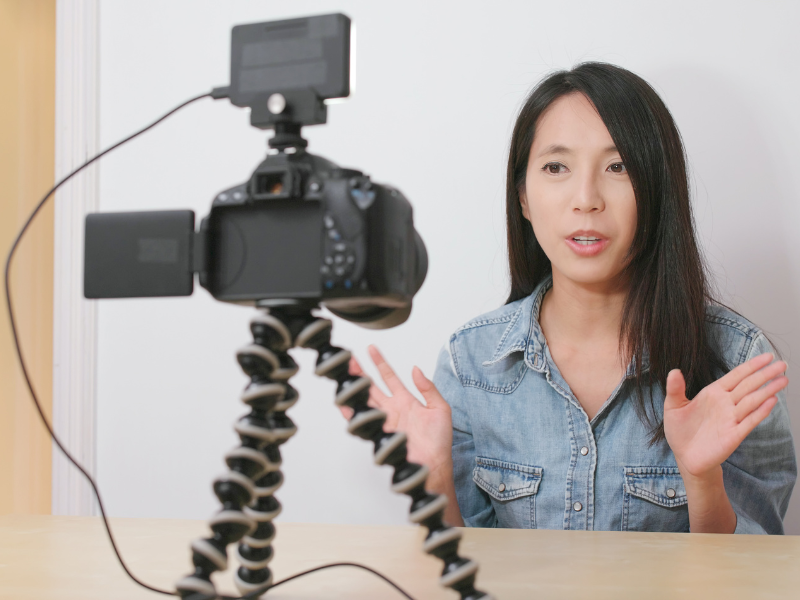
High-quality, professional images can add a whole new dimension to your website and marketing materials. But a lot goes into creating images that will really enhance your business efforts.
To learn more about creating images that will boost your website and marketing materials, take a look at the list of tips below.
Take These Steps for Better Photos
Understand the Importance of Quality
The photos on your website and marketing materials can have a big impact on how customers view your business. So you don’t want to just go with the cheapest or easiest options at the expense of your overall marketing or branding efforts.
Professional photographer and consultant Missy Mwac explained in an email to Small Business Trends, “High quality professional images on a business’s website and marketing materials give the impression of a high quality professional business; they are an indicator of quality.”

Evaluate Your Needs
Before you just start adding photos to your site or setting up photo shoots, you need to decide on what types of photos you want and what they will add to your site or marketing materials. Photos can be incredibly useful in creating visual interest and adding a face to your company. But adding irrelevant photos just for the sake of filling space may not do you any good. So come up with a plan and decide on the photos that are likely to have an actual impact.
Hire a Professional
Smartphones, tablets and other devices have made it easy for people to constantly photograph their lives. But access to a camera doesn’t make you a professional. And customers can usually tell the difference. So if you want better photos that look like they were taken by a professional, hire one.
Mwac says, “You hire a professional when you want a job done right. Professional photographers are business people themselves and know what goes into creating extraordinary images. It’s what they do, which is why when you need something extraordinary, you need to hire a professional.”
Know the Difference Between Professional and Amateur
However, simply hiring someone who calls himself or herself a photographer does not guarantee that you’ll get high quality images. You need to really vet potential candidates to ensure that you’ll get the highest quality and most relevant images for your business.
Mwac says, “There are a lot of pictures being taken in today’s world. From DSLR’s to camera phones to camera tablets, we are a generation that must photograph everything, even our food. (Guilty. I admit it.) And that’s great! I am very much in favor of capturing as much of Life as possible. The memories, the times together … we just don’t get that back, and a photograph is the closest we get to reliving it. But everyone is not a professional photographer … it’s just, well, most everyone has cameras. And the ownership of an object and/or the ability to perform a simple task does not entitle one to claim a certain status.”

Don’t Just Rely on a Website
A quick online search can likely point you to some professional photographers in your area. And while a quick look at their website can potentially give you an idea about their style, it’s not the main thing you should use to base your decision.
See Photo Examples in Person
If possible, visit potential candidates at their studios or set up meetings so that you can meet them and take a look at their work in person. This should give you a better idea of their work and quality, especially if you plan on using photos for tangible marketing materials.
Ask for References
You can also ask photographers you meet with for references or customer testimonials, to ensure that their past clients were happy with the overall experience and finished product.

Find Someone You Like Working With
A photographer’s personality and working style are also important things to consider. You’re likely to need professional photos taken more than once over the course of running your business. So finding someone that you like working with can be extremely beneficial.
Get a Feel for Their Style
You should also consider very carefully if each candidate has a style that would suit your business and the types of photos you want to use. Each photographer is different and has different strengths. So think about which examples best exemplify what you want to see for your business’s photos.
Seek Out Recommendations
If you need help in your search for professional photographers and better photos, ask others for recommendations. See if any friends or fellow business owners have had professional photos taken recently and if they were happy with their results.
Search Your Local Area
You can also simply keep an eye out for photo studios in your local area. Drop by and see if you can meet with a photographer and take a look at some photo examples.
Consider Quality Stock Images
While professional photos created specifically for your business are preferable, it’s not always possible for every business to hire a professional every time they want to post a photo. Particularly if you use a lot of photos in blog posts or similar materials, professional stock photography is a useful option. Sites like iStock, Shutterstock and Fotolia all offer such photos.
But Don’t Skimp on Them
There are also sites that offer free or very low cost stock photos or royalty free images. But you shouldn’t choose low quality images just because they’re low cost. In many cases, you’re better off not adding images over adding low quality ones.
Use Images That Fit with Your Brand
You have much less control when using stock images than you would when working with a professional. But you should still try and select images that fit with your brand’s style, overall aesthetic and your website’s color theme. When possible, use the psychology of color in your images.
Make Sure They are Relevant to Your Specific Message
When working with stock images, you also need to ensure that they’re actually relevant to the page of your website or section of your marketing materials where you want them to appear. If you just add a photo for the sake of adding one, it can be confusing or distracting to customers.
Humanize Your Brand
Professional photos of your products or other offerings are great. But many customers also appreciate a behind the scenes look at your company.
Get Comfortable in Front of the Camera
Part of humanizing your brand means showing your actual team. Adding better photos of you and the other members of your team to your website and other materials can help your customers feel more comfortable reaching out to you or doing business with your company.

Create a Plan for Your Social Images
Aside from the professional or stock photos that you use for your website and official marketing materials, you’ll likely also want to include some images on your social media accounts. These don’t necessarily need to be of the quality that you hold your official website images to, but they should still be relevant to your company and overall marketing strategy.
Take More Photos Than You Need
When taking photos for your social media accounts, you want to have plenty of options to choose from. Always take more photos than you actually need at events or photo shoots. Then you can decide which ones are most worthy of posting later.
Work With Your Team
Your team can also be helpful when taking social images. Ask everyone to submit their images from various events or behind the scenes shots. They might offer a new perspective or just give you some interesting imagery that your customers could appreciate.
Find Good Lighting
Lighting is one of the most essential elements for great photos. Don’t post dark or grainy photos to your social accounts. Instead, try to take photos in natural light or with high quality artificial light. For product images, use a light box.
Don’t Stretch Images
You also need to make sure that your images are large enough to post on the platforms you use. Actual dimensions are different for every platform, but you generally want to start with the largest image size possible, especially if you’re using the .jpg (J-peg) format. Then, before you post, just make sure that your photos don’t look pixelated or stretched out.
Take the Overall Look into Account
Whether it’s your website, social accounts or other marketing materials, you want to make sure that your images add real value to your company’s message. Take a look at your materials as a whole and ensure that your images fit with your message, branding and image. If not, it could be time for a change.
| Key Steps for Enhanced Photos | |
|---|---|
| Understand Quality Impact | The power of high-quality images is paramount. They convey professionalism and excellence, leaving a lasting impression on customers. |
| Strategic Photo Planning | Before adding images, define their purpose. Avoid irrelevant visuals; each image should contribute meaningfully to your brand’s narrative. |
| Engage Professional Photographers | Hiring professionals ensures expertly crafted visuals. Their expertise translates into impactful images that align with your brand’s identity. |
| Vet Credentials and References | Scrutinize photographers’ portfolios and seek client references. A reliable partnership ensures captivating visuals for your business needs. |
| Foster Collaboration and Compatibility | Choose photographers whose working style aligns with your business. Compatibility leads to smoother collaboration and compelling imagery. |
Conclusion
In the dynamic realm of digital marketing, the significance of high-quality, professional images cannot be overstated. These visual assets possess the remarkable ability to elevate your website and marketing materials to new heights, captivating your audience and conveying your brand’s essence in a captivating manner. However, the journey to creating such impactful images is multifaceted, requiring a deliberate and strategic approach that encompasses both visual aesthetics and brand alignment.
The journey towards better photos is not just a technical endeavor; it’s an endeavor that intertwines aesthetics with your brand identity and customer perceptions. Here’s a comprehensive wrap-up of the steps to harness the potential of images that truly resonate with your target audience:
Understanding the Power of Quality
Grasping the pivotal role of high-quality images is the foundation of your visual strategy. Recognize that images are more than just visuals—they are indicators of the quality your business represents. Professional images evoke the impression of a high-caliber enterprise that is dedicated to delivering excellence in all aspects.
Strategizing with Purpose
Before embarking on a photo-driven journey, a strategic blueprint is essential. Understand the purpose behind each image, whether it’s creating visual interest or humanizing your brand. Blanketing your website with irrelevant photos merely for the sake of it could dilute your impact. Every image should have a well-defined role in enhancing your brand narrative.
Collaborating with Professionals
While technology has democratized photography, expertise remains unparalleled. The distinction between professional and amateur photography is palpable to discerning viewers. Entrusting your visuals to experts ensures images that encapsulate the essence of your business, bolstering your credibility and leaving a lasting impression.
Evaluating Credentials
Not all photographers are created equal. Scrutinize potential candidates meticulously to gauge their expertise and compatibility with your vision. A photographer’s portfolio speaks volumes about their style and capabilities. Visiting their studios and engaging in personal interactions adds depth to your assessment, especially when considering tangible marketing materials.
Building Trust with References
Seeking references from past clients is a prudent step to ensure you’re making an informed decision. Testimonials and reviews provide valuable insights into the overall experience and the quality of the end product. This due diligence ensures a more reliable partnership with a photographer whose work resonates with your expectations.
Cultivating Collaboration and Compatibility
A photographer’s personality and working style are integral elements of your decision-making process. Establishing an enduring collaboration is pivotal, given that your business will likely require professional imagery on multiple occasions. Compatibility fosters a smoother working relationship and ultimately translates into captivating visual narratives.
Aligning with Brand and Message
Images should serve as harmonious extensions of your brand’s ethos. Even when utilizing stock photos, aligning them with your brand’s color theme and overall aesthetic is crucial. The psychology of color can further amplify the resonance of your images and evoke desired emotions.
Relevance and Authenticity
Whether sourced from professionals or stock photo repositories, images must seamlessly blend with your brand narrative. Irrelevant or out-of-place visuals can be disorienting and detract from the user experience. Prioritize relevance to convey your intended message authentically.
Humanizing your Brand
Behind-the-scenes glimpses of your company offer customers a personal connection beyond products or services. Sharing candid moments with your team humanizes your brand, instilling a sense of familiarity and fostering trust. These images create relatability and encourage meaningful interactions.
Optimizing for Social Media
Images for social media platforms have a distinct purpose. While they may not require the same level of perfection as official marketing materials, they should still align with your brand’s identity and messaging. Capturing various angles and scenarios offers flexibility when curating your social media content.
Ample Options for Selection
Abundance is your ally when it comes to images. Capture a surplus of photos during events or shoots, allowing you to cherry-pick the most compelling ones. This abundance ensures you always have an array of options to choose from, enhancing the visual variety in your marketing efforts.
Harnessing Team Contributions
Enlist your team’s help in capturing social images. The diverse perspectives and unique insights they offer can yield captivating imagery that resonates with your audience. Collaborative efforts ensure an authentic portrayal of your company culture and its dynamic personalities.
Mastering Lighting and Quality
Lighting is pivotal in image quality. Grainy or dimly lit photos can deter viewers. Prioritize natural light or high-quality artificial lighting to illuminate your subject. For product images, utilizing a lightbox ensures optimal lighting conditions.
Adhering to Platform Standards
Different platforms have varied image dimension requirements. Ensure your images meet these specifications to maintain a professional appearance. Avoid pixelation or stretching, which can compromise the visual integrity of your content.
Coherence with Brand Identity
Finally, ensure that every image contributes to your brand’s overarching narrative. Images should not exist in isolation but harmonize with your brand’s style, message, and image. A cohesive visual identity across various materials enhances your brand’s recognizability and reinforces its essence.
Related reading: Which Marketing Materials Do I Need?
Camera Shutter Photo via Shutterstock
This article, “23 Steps to Better Photos for Your Website and Marketing Materials” was first published on Small Business Trends